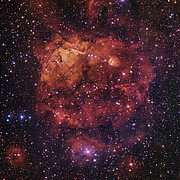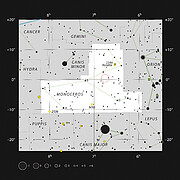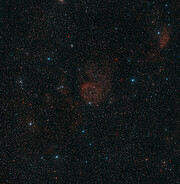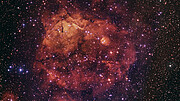Press Release
'Smiling cat' nebula captured in new ESO image
27 June 2023

This cloud of orange and red, part of the Sh2-284 nebula, is shown here in spectacular detail using data from the VLT Survey Telescope, hosted by the European Southern Observatory (ESO). This nebula is teeming with young stars, as gas and dust within it clumps together to form new suns. If you take a look at the cloud as a whole, you might be able to make out the face of a cat, smiling down from the sky.
The Sh2-284 stellar nursery is a vast region of dust and gas and its brightest part, visible in this image, is about 150 light-years (over 1400 trillion kilometers) across. It’s located some 15 000 light-years away from Earth in the constellation Monoceros.
Nestled in the centre of the brightest part of the nebula — right under the ‘cat’s nose’ — is a cluster of young stars known as Dolidze 25, which produces large amounts of strong radiation and winds. The radiation is powerful enough to ionise the hydrogen gas in the cloud, thereby producing its bright orange and red colours. It’s in clouds like this that the building blocks for new stars reside.
The winds from the central cluster of stars push away the gas and dust in the nebula, hollowing out its centre. As the winds encounter denser pockets of material, these offer more resistance meaning that the areas around them are eroded away first. This creates several pillars that can be seen along the edges of Sh2-284 pointing at the centre of the nebula, such as the one on the right-hand side of the frame. While these pillars might look small in the image, they are in fact several light-years wide and contain vast amounts of gas and dust out of which new stars form.
This image was created using data from the VLT Survey Telescope (VST), which is owned by The National Institute for Astrophysics in Italy, INAF, and is hosted at ESO’s Paranal Observatory in Chile. The VST is dedicated to mapping the southern sky in visible light and makes use of a 256-million-pixel camera specially designed for taking very wide-field images. This image is part of the VST Photometric Hα Survey of the Southern Galactic Plane and Bulge (VPHAS+), which has studied some 500 million objects in our home galaxy, helping us better understand the birth, life, and eventual death of stars within our Milky Way.
Links
- Photos of the VST
- Other images taken with the VST
- For journalists: subscribe to receive our releases under embargo in your language
- For scientists: got a story? Pitch your research
Contacts
Juan Carlos Muñoz Mateos
ESO Media Officer
Garching bei München, Germany
Tel: +49 89 3200 6176
Email: jmunoz@eso.org
Bárbara Ferreira
ESO Media Manager
Garching bei München, Germany
Tel: +49 89 3200 6670
Cell: +49 151 241 664 00
Email: press@eso.org
About the Release
| Release No.: | eso2309 |
| Name: | Sh2-284 |
| Type: | Milky Way : Nebula : Appearance : Emission : H II Region |
| Facility: | VLT Survey Telescope |
| Instruments: | OmegaCAM |
Our use of Cookies
We use cookies that are essential for accessing our websites and using our services. We also use cookies to analyse, measure and improve our websites’ performance, to enable content sharing via social media and to display media content hosted on third-party platforms.
ESO Cookies Policy
The European Organisation for Astronomical Research in the Southern Hemisphere (ESO) is the pre-eminent intergovernmental science and technology organisation in astronomy. It carries out an ambitious programme focused on the design, construction and operation of powerful ground-based observing facilities for astronomy.
This Cookies Policy is intended to provide clarity by outlining the cookies used on the ESO public websites, their functions, the options you have for controlling them, and the ways you can contact us for additional details.
What are cookies?
Cookies are small pieces of data stored on your device by websites you visit. They serve various purposes, such as remembering login credentials and preferences and enhance your browsing experience.
Categories of cookies we use
Essential cookies (always active): These cookies are strictly necessary for the proper functioning of our website. Without these cookies, the website cannot operate correctly, and certain services, such as logging in or accessing secure areas, may not be available; because they are essential for the website’s operation, they cannot be disabled.
Functional Cookies: These cookies enhance your browsing experience by enabling additional features and personalization, such as remembering your preferences and settings. While not strictly necessary for the website to function, they improve usability and convenience; these cookies are only placed if you provide your consent.
Analytics cookies: These cookies collect information about how visitors interact with our website, such as which pages are visited most often and how users navigate the site. This data helps us improve website performance, optimize content, and enhance the user experience; these cookies are only placed if you provide your consent. We use the following analytics cookies.
Matomo Cookies:
This website uses Matomo (formerly Piwik), an open source software which enables the statistical analysis of website visits. Matomo uses cookies (text files) which are saved on your computer and which allow us to analyze how you use our website. The website user information generated by the cookies will only be saved on the servers of our IT Department. We use this information to analyze www.eso.org visits and to prepare reports on website activities. These data will not be disclosed to third parties.
On behalf of ESO, Matomo will use this information for the purpose of evaluating your use of the website, compiling reports on website activity and providing other services relating to website activity and internet usage.
Matomo cookies settings:
Additional Third-party cookies on ESO websites: some of our pages display content from external providers, e.g. YouTube.
Such third-party services are outside of ESO control and may, at any time, change their terms of service, use of cookies, etc.
YouTube: Some videos on the ESO website are embedded from ESO’s official YouTube channel. We have enabled YouTube’s privacy-enhanced mode, meaning that no cookies are set unless the user actively clicks on the video to play it. Additionally, in this mode, YouTube does not store any personally identifiable cookie data for embedded video playbacks. For more details, please refer to YouTube’s embedding videos information page.
Cookies can also be classified based on the following elements.
Regarding the domain, there are:
- First-party cookies, set by the website you are currently visiting. They are stored by the same domain that you are browsing and are used to enhance your experience on that site;
- Third-party cookies, set by a domain other than the one you are currently visiting.
As for their duration, cookies can be:
- Browser-session cookies, which are deleted when the user closes the browser;
- Stored cookies, which stay on the user's device for a predetermined period of time.
How to manage cookies
Cookie settings: You can modify your cookie choices for the ESO webpages at any time by clicking on the link Cookie settings at the bottom of any page.
In your browser: If you wish to delete cookies or instruct your browser to delete or block cookies by default, please visit the help pages of your browser:
Please be aware that if you delete or decline cookies, certain functionalities of our website may be not be available and your browsing experience may be affected.
You can set most browsers to prevent any cookies being placed on your device, but you may then have to manually adjust some preferences every time you visit a site/page. And some services and functionalities may not work properly at all (e.g. profile logging-in, shop check out).
Updates to the ESO Cookies Policy
The ESO Cookies Policy may be subject to future updates, which will be made available on this page.
Additional information
For any queries related to cookies, please contact: pdprATesoDOTorg.
As ESO public webpages are managed by our Department of Communication, your questions will be dealt with the support of the said Department.






